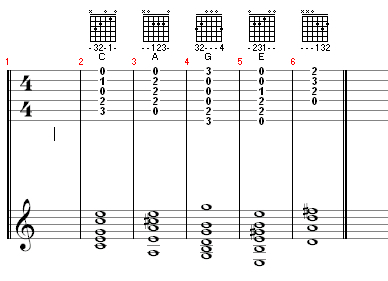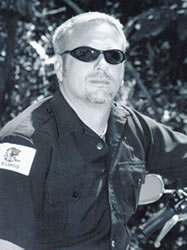One of the most common difficulties I face when teaching new guitarists, especially Metal Heads, is that they want to jump right over these chord shapes and go straight into the two fingered power chords. Ah, the lure of the Darkside. Many a young Jedi has been swept away in its influence.
(Cue Napoleon Dynamite holding a Flying V.)
Ouch, but it hurts?!
Yes, I know. Pushing your fresh pink finger tips against the first fret will force your whole body to contort in ways that only the Elephant man can identify with. The F Chord has been used for years by the Chinese as a way to torture small children into submission. Or. Maybe that was just me with my kids. Anyways, if it hurts, your pushing to hard. Either that or your a big dork. Just follow some of my playing tips and remember to go slow.
Let’s get started:
Below is a small graphic that contains pictures of the chord shapes that we will start with. You will see: Tab of the fret positions, standard notation, and fingering suggestions. Everything you need to get started is right here.

You will notice that I have put the chords in the order of: C, A, G, E, D
This is because later we will refer to this pattern as the CAGED sequence. Yes, like a convenience store Burrito, this will come back to haunt you.
Playing Tips:
Thumb on the back of the neck, centered with the hand. Comfortable variations are acceptable.
You do not need to press hard to get the note to ring properly. Instead, gently put your fingers into position, and then slowly start to push down, harder and harder, until the note sounds. Pushing too hard on the strings is the most common mistake to make.
Damn dude, I got a buzz.
Gently try to reposition some of your fingers so that they do not touch the other strings. Sometimes gently arching some of the fingers will help.
Play all the notes of the chord. Strum them all at once, try picking them one at a time.
Don't play the strings that are not part of the chord. For example, to play the D chord you only strum the top 4 strings, starting with the open D String. The G chord is played on all 6 strings. Take a look at the tab if you get confused.
Don’t strain! If you hand hurts, fingers hurt, or your thumb hurts, take a break!
Homework:
- Buy dad something cool for father’s day, preferably a cool toy that he can play with.
- Learn to play every chord.
- Learn to play them without looking at the fingering chart.
- Know the name of the chord you are playing.
- Play them in order, then, switch them around.
- Go SLOW! Don’t practice making mistakes.
Even the longest journey starts with a single step. Or in the case of my grandmother, it starts with a step towards the bathroom. Take your time, go slow, and don’t get discouraged. I know you can do it.



